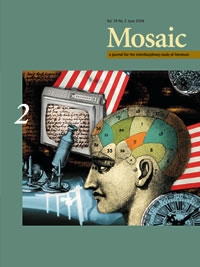Issue 39.2
Overview

General Issue
Published: June 2006
View the issue introduction or see the issue summary and contents below.
10 essays, totalling 192 pages
$16.95 CAD
One of the compelling themes taken up in this issue is that of literature’s relation to violence. What is the “poetics of violence”? and what might be the relation of art to terror? Look for several different answers to these questions in the ten essays this issue includes: Sharon Smulders, “’A Double Assault’: The Victimization of Aboriginal Women and Children in In Search of April Raintree;” Leonard Wilcox, “Terrorism and Art: Don DeLillo’s Mao II and Jean Baudrillard’s The Spirit of Terrorism;” Walter Corbella, “Strategies of Resistance and the Problem of Ambiguity in Azar Nafisi’s Reading Lolita in Tehran;” Hye Ryoung Kil, “Conrad’s ’Undying Hope’ of the Polish Nation: Western Ideal and Eastern Reality;” Christine Kim, “Postcolonial Romance, Ghostly Love Stories, and The Heart Does Not Bend;” Andrew Hock-Soon Ng, “Malaysian Gothic: The Motif of Haunting in K. S. Maniam’s ’Haunting the Tiger’ and Shirley Lim’s ’Haunting;’” Halia Koo, “(Wo)men Travellers: Physical and Narrative Boundaries;” Tara Collington, “Self and Narrative in Le Ravissement de Lol V. Stein;” Tita Chico, “Minute Particulars: Microscopy and Eighteenth-Century Narrative;” Carol Ann Wald, “Reflexivity, Reproduction, and Evolution: From von Neumann to Powers.”
Conrad’s “Undying Hope” of the Polish Nation: Western Ideal and Eastern RealityHye Ryoung Kil The idealistic protagonists in Conrad’s novels represent the individualistic and democratic “Western” tradition of Poland before her destruction by “Eastern” autocracy. The reconciliation between the republican tradition, inherited by the Polish revolutionaries in the nineteenth century, and the autocratic reality of Russian Poland suggests the rebirth of the Polish nation. | |
(Wo)men Travellers: Physical and Narrative BoundariesHalia Koo This essay analyzes the strategies of self-representation in the travel narratives of two women who visited Persia disguised as men. It demonstrates how cross-dressing can affect female subjectivity, and how radically the role of masquerade can change in situations that combine sensitive issues such as imperialism, religion, and gender. | |
“A Double Assault”: The Victimization of Aboriginal Women and Children in In Search of April RaintreeSharon Smulders In In Search of April Raintree, Beatrice Mosionier (formerly Culleton) enables metaphors of enforced acculturation drawn from the material facts of Aboriginal existence. Testifying to the traumatic realities of foster care and rape, she analyzes and indicts the systematic oppression of Aboriginal women and children in Canada. | |
Postcolonial Romance, Ghostly Love Stories, and The Heart Does Not BendChristine Kim Through a discussion of Makeda Silvera’s The Heart Does Not Bend and theories of mourning and melancholia, this essay opens up pressing questions about black subjectivity, the politics of diasporic, gendered, and sexual identities, and the social economies within which they circulate. | |
Malaysian Gothic: The Motif of Haunting in K.S. Maniam’s “Haunting the Tiger” and Shirley Lim’s “Haunting”Andrew Hock-Soon Ng This essay, read against the frameworks of the male and female Gothic plots, unpacks and reconfigures the motif of “haunting” to address the interrelation between notions of sexuality, gender, and national belonging in two Malaysian short stories. | |
Terrorism and Art: Don DeLillo’s Mao II and Jean Baudrillard’s The Spirit of TerrorismLeonard Wilcox While Don DeLillo and Jean Baudrillard hold similar views about postmodern terrorism, they differ regarding the relationship between terrorism and art. For Baudrillard, the sacrificial violence of terrorism is an “artwork” that subverts hyperreal culture. For DeLillo, art remains the best hope for resisting a regime of media and spectacle. | |
Strategies of Resistance and the Problem of Ambiguity in Azar Nafisi’s Reading Lolita in TehranWalter Corbella Blending autobiographical elements, critical readings of Western literature, and socio-political commentary on the Iranian situation, Nafisi recounts her experiences in the Islamic Republic of Iran in the period between 1977 and 1997. This article focuses on her deployment of resistant strategies against oppression, examining how her frequent ambiguities undermine their subversive potential. | |
Self and Narrative in Le Ravissement de Lol V. SteinTara Collington This essay adopts an interdisciplinary approach to Duras’s Le Ravissement de Lol V. Stein, examining the intersection between psychoanalysis and literary criticism. Temporal continuity and spatial cohesion are considered shared characteristics of both the self and narrative in this examination of how identity fragmentation is reflected in the structure of a text. | |
Minute Particulars: Microscopy and Eighteenth-Century NarrativeTita Chico This essay argues that writings on microscopy are preoccupied by defining and defending the minute particular—small things not ordinarily apprehended—and that this focus and anxiety are likewise registered in eighteenth-century fictional narratives. The increased status of the minute particular signals the popularization and domestication of empiricism into eighteenth-century narrative. | |
Reflexivity, Reproduction, and Evolution: From von Neumann to PowersCarol Ann Wald This essay explores reflexivity, reproduction, and evolutionary discourse in John von Neumann’s “Theory of Self-Reproducing Automata” and, using Maturana and Varela’s notion of autopoiesis, connects cybernetic conceptions of reflexivity to Richard Powers’s novel, Galatea 2.2. In this novel, it is argued, the reflexive dynamics of cognitive complexity become entangled with anxieties about parenting and evolutionary progress. |